If you think you don’t have time to teach grammar, then grammar warm-ups are your solution! The minute students walk into class, warm-ups set a productive tone for the period. Plus, they sharpen students’ language while hitting ELA standards.
Keep reading to discover nine helpful hints to make teaching grammar easy, ensuring success for you and your students.
Grammar Warm-Up Exercises
Since you’re teaching ELA, you’ll want to assign warm-ups that incorporate reading and writing objectives. Consider focusing on grammar for the most part. Why? Students haven’t had enough exposure to these objectives, and they need daily practice for mastery.
At the same time, instead of assigning the same type of warm-up every day, mix it up while remaining consistent. For example, here’s the schedule I follow:
Monday Warm-Ups (Reading and Writing)
My students complete longer warm-ups, ones that take five to ten minutes, such as responding to a quote or reading a short passage and answering questions. This allows me to address other skills we’re focusing on (e.g., theme, summary, inference, etc.).

Tuesdays through Thursdays (Grammar)
I use grammar warm-ups on these days and focus on one concept at a time for three weeks (four if students need additional time for mastery). Begin with sentence combining and move to imitating and writing sentences.

Teaching would be easier if we could give students a worksheet and see them implement the concept into their writing, but learning isn’t that simple. Students need practice to master grammar rules. What’s great about grammar warm-ups is that you can give them the practice and repetition they need with five minutes a day.
Fridays (Puzzles)
I like to use a quick and fun warm-up like rebus puzzles. Students love them, and it seems like the warm-up completion rate increased when I started ending the week with these. Plus, they do require students to infer.
If you’d like more ELA warm-up ideas, visit my blog post: “7 Easy ELA Warm-Ups to Improve Reading and Writing Skills.” Also, at the end of the post, you can snag some free comma rule lessons, including warm-ups that focus on comma usage.
When to Begin Grammar Warm-Ups
To establish a routine, begin assigning warm-ups on the first day of school. However, instead of focusing on grammar the first week, consider taking care of business to-dos. This allows time to introduce grammar concepts you’ll be studying (such as an overview of comma rules), giving students a foundation before asking them to work with them on week two. At the same time, it helps students know what to expect from day one.
Here are some warm-up ideas I’ve used the first week of school:
Name Plates
Have students create alliterated nameplates to keep on their desks during class. This will help you learn their names faster, and the alliteration allows you to learn about a student. (I can tell you some stories about Lucky Larry!)
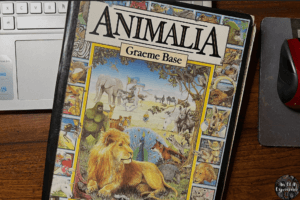
I read and review a few pages from Graeme’s Base’s Animalia to reintroduce students to alliteration. In this book, Base has alliterated every letter of the alphabet with phrases like, “Diabolical Dragons Daintily Devouring Delicious Delicacies.” Along with that, he’s created a picture type of alliteration too because the illustrations begin with the same letter. As if that’s not enough, he’s also hidden himself pictured as a boy on every page. My students enjoy browsing through this book whenever they have an extra minute. (You can see how much it’s been loved by the condition of my copy!)
Class Schedule
Ask students to take a picture of their schedules or copy them onto a sheet of paper for you to keep. By doing this, they’ll have a copy if the original gets misplaced.

Index Card
Have students write their names at the top of the cards and answer three questions.
- What makes learning easy for you?
- What makes learning difficult for you?
- What is one thing you want me to know about you?
Use the cards throughout the year to randomly call on students instead of choosing the ones whose hands are raised or who are off task. As you call on students, you can scan the cards for reminders about them.
You’ll also find it helpful to color code the cards by period.
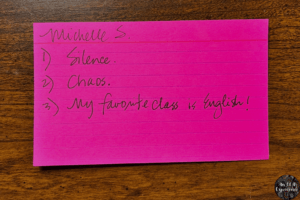
Contact Information Sheet
With today’s technology, many school districts have this information available online. However, I’ve read that this is not true for all districts. Ask for the students’ names, phone numbers, parents’ numbers, class schedules, etc. Place these in a binder organized by periods and note parent contacts here as you make them.
Time Capsule Handout
Middle schoolers change a lot during the school year, so it’s fun for them to see these changes. Ask them to note their favorite books, friends, movies, sports, hobbies, subjects, and other information like their height. At the end of the year, have them answer the same questions without looking at their initial responses. Then they can compare the two to see how they’ve grown. Best friends change, and some kids sprout three inches during one school year!
Remind
Ask students to sign up for a Remind account. This is a great, free tool to send reminders to students (and parents) of important dates (e.g., Red Ribbon Week, library days, school holidays, early release days, tests, updates, announcements, etc.). With the app, it’s as simple as sending a text from your phone (one text that is delivered to everyone at once).
If it’s the middle of the school year, skip this first week and start grammar warm-ups today. You know the saying: It’s better now than never.
Monitoring Grammar Warm-Up Completion
As soon as students enter the room, have the warm-up displayed on your screen so they can begin. While they are working on the warm-up, you take and input attendance. After you finish, select a group of three or four students, and quickly check their warm-ups. If they completed it correctly, draw a happy face next to it. 🙂 If it’s incorrect, explain how they can fix it.
Why do this? There is often a student or two who will wait for the answer before completing the warm-up, and they’re not going to learn by simply copying an answer.
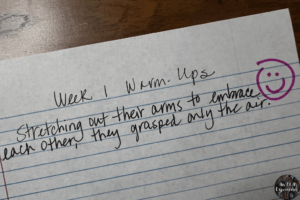
Creating Student Success with Warm-Ups
Whether the warm-up is covering reading, writing, or puzzles, show and review the answer and allow students to make corrections. This will help them learn and retain the information. For example, when combining compound sentences, some students will place the comma after the coordinating conjunction instead of before. It’s a simple correction. They see what they did wrong, and they fix it. The same is true for rebus puzzles. When you first introduce these, students will be confused, but after reviewing the answers, they will start mastering these puzzles.
We want every student to find success, and allowing corrections is one step toward achieving this goal.
Fun Warm-Ups for English Class
Add something engaging and ELA-related to Fridays to increase student motivation.
Rebus puzzles are only one fun warm-up you can try. Here are some other ideas:
- List as many items as possible that are red (or blue or orange).
- Note as many words as you can find in compound sentences (or appositives or participles).
- Watch the video (or view the picture) and write a compound sentence (or complex or cumulative).
- Discuss a would-you-rather or this-or-that question with your group members. (Spark Creativity has three weeks for free on her blog and more for sell in her TPT store.) I used these last year as attendance questions, and they are great for relationship-building between students and students and teachers.

- Perplexors offer another fun way to practice inferencing skills. I used these in my middle school GT ELA classes, but they’re great for other subjects and available for different levels.
Grading Grammar Warm-Ups
Collect Warm-Ups Every Friday
Assign warm-ups to students daily, but only collect them on Fridays. (Students can write their responses on one sheet of paper, and even middle schoolers can manage to hold onto them for a week.)
Grade Every Three Weeks
You’ve heard the don’t-grade-everything advice, and this is true for warm-ups. They’re easy to grade, but you don’t have time to grade all of them, nor do you want to fill your grade book with warm-up marks.
I spend three weeks on each grammar concept and grade them at the end of that period. This way I can see if students mastered the rule before I move on to the next one. (If they haven’t, then I’ll spend another week on that rule.)
Scoring Grammar Warm-Ups
Here’s how I grade warm-ups:
Students lose twenty points if they do not complete the warm-up and five points when an error is made. I deduct five points for mistakes, including missing periods and opening capital letters (because they should know these rules by now). I don’t take more than ten points off for one warm-up so students’ scores will not be lower than a fifty (unless they do not complete the warm-up). I do not deduct points for spelling errors unless we’re working on specific spelling rules. At the same time, if I’m working on a specific comma rule, I’ll deduct five points for a missing or misplaced comma.
Believe it or not, I like grading warm-ups. They don’t take long to score, and I especially love the creative sentences students come up with.
Publishing Students’ Sentences
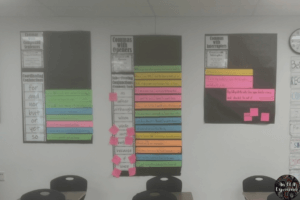
When grading students’ original sentences, draw stars next to your favorites. Teach students to look for the stars and write their sentences on sentence strips when they see one (or directly on the butcher paper). (I make student names optional on sentence strips, but most of them like to include them.)
Tape these to a wall chart for publication and a resource students can refer to.
Absent Students
When students are absent, have them write “absent” for the missing warm-up. (I used to have them make up the warm-ups, but I’ve found this a timesaver for everyone. Plus, it’s not a huge deal if they miss one warm-up.)
However, if a student is absent for an entire week, consider having them complete it, especially if you’re taking a grade on it.
With today’s technology, students can access assignments on an LMS (learning management system) like Schoology or Google Classroom.
If your school does not utilize an LMS, print the warm-ups for them (with six slides on each sheet of paper).
Apply Grammar Warm-Up Learning to Writing
Whatever concept you’re covering with your grammar warm-ups, remember to have students apply that learning to their writing. For example, when you’re studying appositive phrases and writing persuasive essays, ask students to add and underline an appositive phrase in their essays. The underlining allows you to quickly locate the sentence and assess mastery.
Related Links
For more ELA warm-up ideas, visit “7 Easy ELA Warm-Ups to Improve Reading and Writing Skills.”
Also, remember to check out the free comma resources at the bottom of this page (including warm-ups) and my grammar warm-up bundle on Teachers Pay Teachers.
Grammar Warm-Up Hints in a Nutshell
- Use a variety of ELA-related warm-ups with a set schedule.
- Start assigning them on the first day of school.
- Monitor completion with a happy face.
- Allow for corrections.
- Use fun English warm-ups on Fridays.
- Collect warm-ups at the end of each week.
- Grade them every three weeks.
- Publish students’ sentences on wall charts.
- Ask students to write “absent” when they miss a day of class.
- Have students apply their learning to their writing.
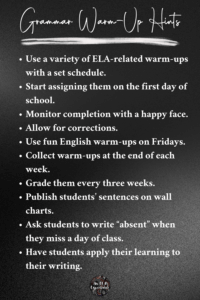
Thank you for reading! If you have any questions or suggestions for grammar warm-ups, please comment below.


